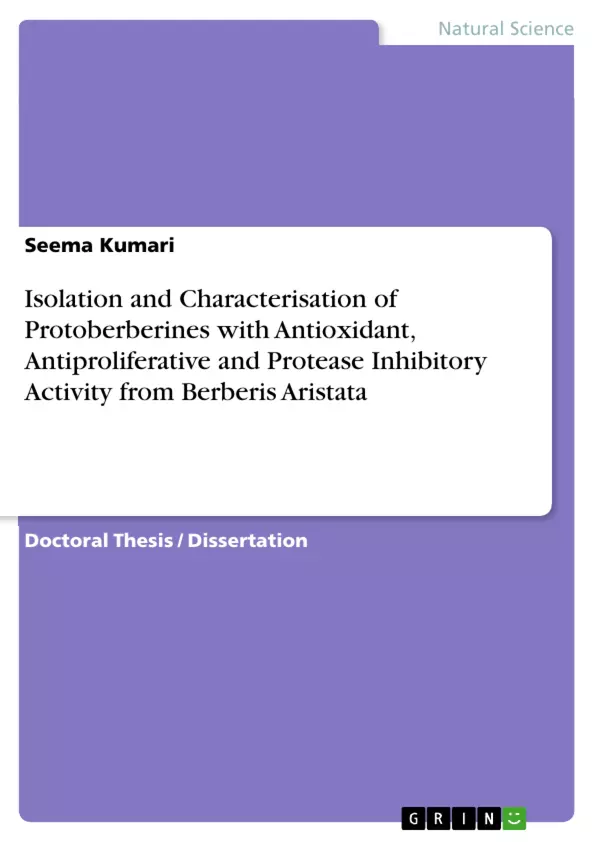Antioxidants are vital substances protecting cells from oxidative damage of biological molecules like DNA, proteins, lipids and maintain normal homeostasis in cell by scavenging free radicals. Oxidative stress is one of the major source of free radicals and causing disorders like multiple sclerosis, Alzheimer’s, Parkinsons, cardiovascular diseases, and other degenerative disorders. Antioxidants finds application in medicine as they, act as immunoregulators, fight against ageing and also reported to induce apoptosis, cell cycle arrest against some cancer cell lines. Antioxidant also finds application in cosmetic industry and even as topical formulation. They are used as a preservative and also to increase the shelf life of frozen fish, canned mushrooms, meat, juice and general foods.
Studies suggested that medicinal plants are a potential, inexpensive and safe source of antioxidants as they are enriched with bioactive compounds.
Berberies aristata is commonly called as Daruhaldi or Chitra belongs to family Berberidaceae. The use of root extract as antipyretic, antiseptic, in the treatment of conjunctivitis, ulcers and hepatic disorders have been reported in earlier studies by various workers. The plant has been used for treatment of skin diseases, inflammation, diarrhoea and jaundice.
Medicinal plants in the present study were screened for their antioxidant potential against different radicals like DPPH, superoxide, hydroxyl and peroxide. Among them ethanolic roots extract B.aristata exhibit highest antioxidant ability and least IC50 value.
Thus further, the ethanolic root extract of B.aristata was subjected to activity guided isolation of antioxidants. Upon liquid-liquid fractionation ethyl acetate fraction exhibited highest radical scavenging activity against DPPH and peroxide radicals. In addition, the IC50 for DPPH radical scavenging and inhibition of lipid peroxidation were significantly less compared to crude ethanol extract indicating quality of antioxidants in ethyl acetate fraction.
Inhaltsverzeichnis (Table of Contents)
- Introduction
- Screening of Different Solvent Extracts of Medicinal Plants for their Antioxidant Potential
- Activity Guided Isolation of Antioxidants from Ethanolic Extract of B.aristata
- Protective Role of Ethyl Acetate Fraction of B.aristata Against Hydrogen Peroxide Induced Stress
- Purification of Antioxidant Compounds from Ethyl Acetate Fraction by Silica Gel Column Chromatography
- Docking of Protoberberines with ECM Proteases, Caspase-3 and Telomeric DNA
- Antioxidant, Antiproliferative and Antiprotease Effects of the Protoberberines
Zielsetzung und Themenschwerpunkte (Objectives and Key Themes)
This thesis aims to investigate the antioxidant, antiproliferative, and protease inhibitory properties of protoberberines isolated from the medicinal plant Berberis aristata. It focuses on identifying and characterizing these compounds and exploring their potential therapeutic applications.
- Antioxidant activity of protoberberines
- Antiproliferative activity of protoberberines
- Protease inhibitory activity of protoberberines
- Structure-activity relationship of protoberberines
- Potential therapeutic applications of protoberberines
Zusammenfassung der Kapitel (Chapter Summaries)
- Chapter 1: Introduction - This chapter provides an overview of antioxidants, their role in protecting cells from oxidative damage, and the therapeutic applications of medicinal plants.
- Chapter 2: Screening of Different Solvent Extracts of Medicinal Plants for their Antioxidant Potential - This chapter investigates the antioxidant activity of different solvent extracts of various medicinal plants using DPPH, superoxide, hydroxyl, and peroxide radical scavenging assays. The ethanolic roots extract of B.aristata exhibits the highest antioxidant ability and the lowest IC50 value.
- Chapter 3: Activity Guided Isolation of Antioxidants from Ethanolic Extract of B.aristata - This chapter focuses on the isolation and characterization of antioxidants from the ethanolic extract of B.aristata using liquid-liquid fractionation and silica gel column chromatography. The ethyl acetate fraction exhibits the highest radical scavenging activity and is identified as a potential source of antioxidant alkaloids.
- Chapter 4: Protective Role of Ethyl Acetate Fraction of B.aristata Against Hydrogen Peroxide Induced Stress - This chapter examines the protective effects of the ethyl acetate fraction of B.aristata against hydrogen peroxide-induced stress in E.coli and APPH-induced lysis in RBC models. The findings suggest that B.aristata protects against lipid and protein peroxidation and H2O2-induced lymphocyte genomic DNA fragmentation.
- Chapter 5: Purification of Antioxidant Compounds from Ethyl Acetate Fraction by Silica Gel Column Chromatography - This chapter details the purification of antioxidant compounds from the ethyl acetate fraction using silica gel column chromatography and their characterization using UV-visible, IR, and NMR spectroscopic methods. Three different protoberberines are isolated and identified as berberrubine, jatrorrhizine, and thalifendine. These compounds exhibit significant antioxidant activity.
- Chapter 6: Docking of Protoberberines with ECM Proteases, Caspase-3 and Telomeric DNA - This chapter explores the interactions of the isolated protoberberines with ECM proteases, caspase-3, and telomeric DNA through in silico docking studies. The findings reveal that all three compounds form stable complexes with caspase 3, cathepsin B, and telomeric DNA, suggesting potential antiproliferative and antiprotease activities.
Schlüsselwörter (Keywords)
Berberis aristata, protoberberines, antioxidants, antiproliferative, protease inhibitors, DPPH radical scavenging, caspase-3, MMP-9, cathepsin B, telomeric DNA, medicinal plants, ethanolic extract, ethyl acetate fraction, in silico docking, in vitro assays.
- Citar trabajo
- Seema Kumari (Autor), 2012, Isolation and Characterisation of Protoberberines with Antioxidant, Antiproliferative and Protease Inhibitory Activity from Berberis Aristata, Múnich, GRIN Verlag, https://www.grin.com/document/302826



